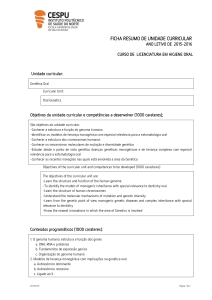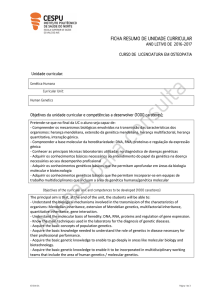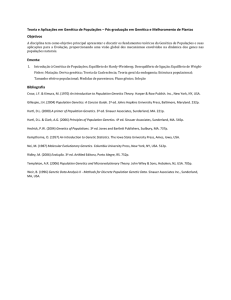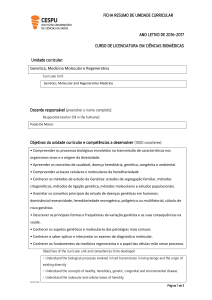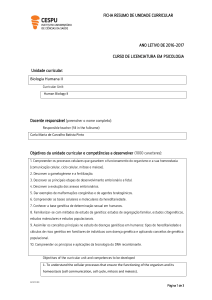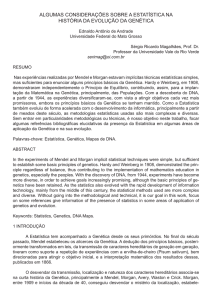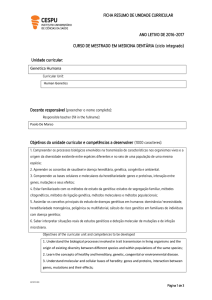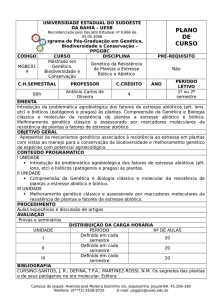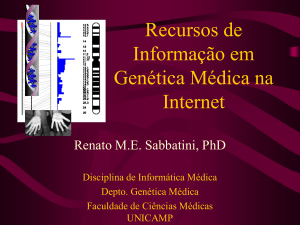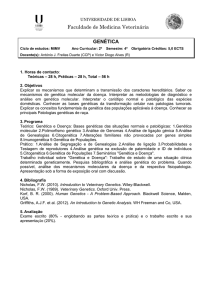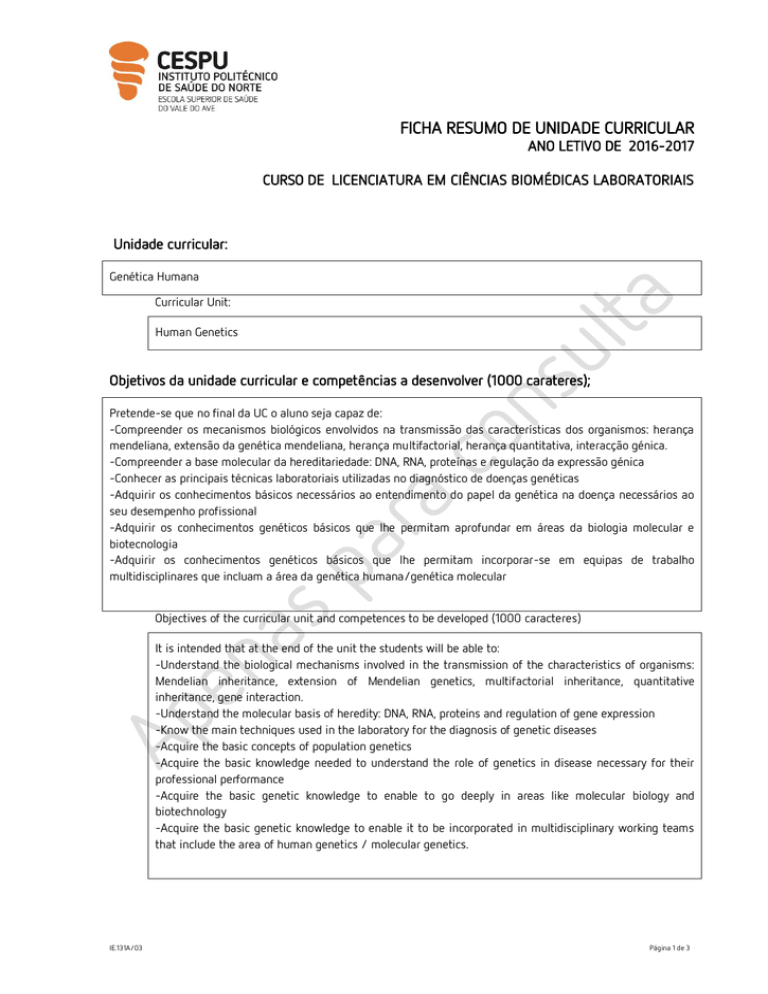
FICHA RESUMO DE UNIDADE CURRICULAR
ANO LETIVO DE 2016-2017
CURSO DE LICENCIATURA EM CIÊNCIAS BIOMÉDICAS LABORATORIAIS
Unidade curricular:
Genética Humana
Curricular Unit:
Human Genetics
Objetivos da unidade curricular e competências a desenvolver (1000 carateres);
Pretende-se que no final da UC o aluno seja capaz de:
-Compreender os mecanismos biológicos envolvidos na transmissão das características dos organismos: herança
mendeliana, extensão da genética mendeliana, herança multifactorial, herança quantitativa, interacção génica.
-Compreender a base molecular da hereditariedade: DNA, RNA, proteínas e regulação da expressão génica
-Conhecer as principais técnicas laboratoriais utilizadas no diagnóstico de doenças genéticas
-Adquirir os conhecimentos básicos necessários ao entendimento do papel da genética na doença necessários ao
seu desempenho profissional
-Adquirir os conhecimentos genéticos básicos que lhe permitam aprofundar em áreas da biologia molecular e
biotecnologia
-Adquirir os conhecimentos genéticos básicos que lhe permitam incorporar-se em equipas de trabalho
multidisciplinares que incluam a área da genética humana/genética molecular
Objectives of the curricular unit and competences to be developed (1000 caracteres)
It is intended that at the end of the unit the students will be able to:
-Understand the biological mechanisms involved in the transmission of the characteristics of organisms:
Mendelian inheritance, extension of Mendelian genetics, multifactorial inheritance, quantitative
inheritance, gene interaction.
-Understand the molecular basis of heredity: DNA, RNA, proteins and regulation of gene expression
-Know the main techniques used in the laboratory for the diagnosis of genetic diseases
-Acquire the basic concepts of population genetics
-Acquire the basic knowledge needed to understand the role of genetics in disease necessary for their
professional performance
-Acquire the basic genetic knowledge to enable to go deeply in areas like molecular biology and
biotechnology
-Acquire the basic genetic knowledge to enable it to be incorporated in multidisciplinary working teams
that include the area of human genetics / molecular genetics.
IE.131A/03
Página 1 de 3
Conteúdos programáticos (1000 carateres):
Aulas teóricas
1. Genética mendeliana
Herança dominante/recessiva,
Cruzamento monohíbridos/dihíbridos
Estudos familiares: Árvores genealógicas humanas
2. Extensões da Genética mendeliana
Dominância parcial, Codominância,
Alelos múltiples e letais
Herança influenciada pelo sexo
Genes no cromossoma X
Interacção génica e Epistase
Herança mitocondrial
Componente ambiental
3. Genética quantitativa
4. Ligação e mapeamento cromossómico
5. O genoma humano
6. Variação genética entre os indivíduos:mutação
7. Variação cromossómica
8. Noções básicas de genética de populações
Frequências alelicas e genotípicas
Lei de Hardy-Weinberg
9. Tecnologia genética: aplicações
Aulas Teórico-práticas
-Exercícios sobre: genética mendeliana, extensões da genética mendeliana, genética quantitativa, cálculo de risco
em famílias
-Problemas sobre genética de populações
Aulas práticas
-Protocolos laboratoriais para a análise molecular de ácidos nucleicos
-Análise de cariótipos
Syllabus (1000 caracteres)
Lectures
1. Mendelian genetics
Autosomal dominant/recessive
Monohybrid/dihybrid cross
Studies of human pedigrees
2 . Extensions of Mendelian Genetics
Partial dominance, codominance
Múltiples and lethal alleles
Inheritance influenced by gender
Genes at chromosome X
Epistatic and gene interaction
Mitochondrial inheritance
Environmental component
3 . Quantitative genetics
4 . Linkage and chromosomal mapping
5 . The human genome
IE.131A/03
Página 2 de 3
6 . Genetic variation among individuals: mutation
7. Chromosome variation
8 . Basics of population genetics
Allelic and genotypic
Hardy- Weinberg Law
9 . Genetic technology: aplications
Theoretical and practical lessons
- Exercises on: Mendelian Genetics , Extensions of Mendelian genetics , quantitative genetics , risk
calculation in families
- Problems on population genetics
Practical classes
- Laboratory protocols for molecular analysis of nucleic acid
- Analysis of karyotypes
Referências bibliográficas (máximo três títulos):
1. Klug WS, Cummings MR, Spencer C, Palladino MA. (2009). Concepts of Genetics. (9th ed). Benjamin
Cummings/Prentice Hall..
2. Lewis R (2008). Human Genetics: Concepts and Applications. (8thed). McGraw-Hill.
3. Passarge, E. (2007). Color atlas of Genetics. (3rd ed). Thieme
IE.131A/03
Página 3 de 3

